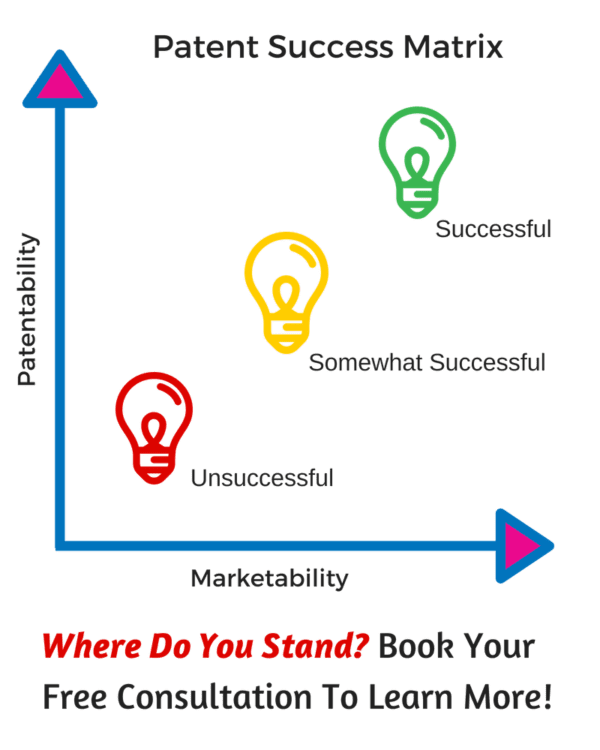BOLD INVENTOR PROCESS

Patentability Search
- Takes 4-6 Weeks
- Answer on Patentability/Scope
- Recommended Path Forward
Initial Consultation
- Eligibility Issues
- Discuss Opportunities
- Inventorship/Ownership
- Long-Term Business Goals
Provisional Patent Application
- Takes 6-8 Weeks
- “Patent Pending” Status
- Develop Enabling Disclosure
- Specification & Drawings
Non-Provisional Patent Application
- Takes 8-10 Weeks
- Update Specification/Drawings
- Draft Claim Language
- Formal Submittal to USPTO (file non-provisional patent)
Note: Submittal of the Non-Provisional Patent Application “C” must be done within 1 year of submittal of the Provisional Patent Application “B” date to secure the early Provisional Priority Date.
Get Started With a Discovery Call!
What Is the Patent Application Process?
An application for a non-provisional patent is an important step in securing and protecting your intellectual property rights. While the process can seem overly complicated, it is important to understand the basics before you file non-provisional patent applications. Learn more about the application process below.
Utility (Non-Provisional) Patent Applications
A non-provisional patent application is more formal than the provisional and it must contain all of the detailed sections such as a brief description of drawings, summary of the invention, background, field of invention disclosure, and most importantly the claims. Unlike the provisional, the non-provisional patent application must point out and distinctly claim the elements of the invention they are claiming is their own. Claim terminology for a non-provisional patent is nearly a language unto its own – and requires a true skill to craft in such a manner so as to grant the inventor the broadest possible rights without encroaching into another’s patent rights. An application for a non-provisional patent may supersede and claim the priority of a provisional application when the invention as described and claimed in the application for the non-provisional patent was fully described in the provisional. The non-provisional patent filing is what gets examined by the USPTO and is the application that may eventually be allowed to issue as a patent.
Design Patent Applications
For a client that wishes to protect only the way something looks or appears. This special type of patent application requires a very detailed approach to defining the shapes, orientation, and ornamental features of the invention. It is important to note that the protection given by a design patent (once issued) is limited to the ornamental appearance of the invention, not how the invention functions. A design patent protects only how the invention looks.
Plant Patent Application
Plant patent applications are available for those inventors or applicants who have found a new species of plant which has been reproduced without the need for natural pollination or nature (asexually reproduced). Examples of these types of patents are for different strains of hops, fruit trees, and grapes (for wine). Just like utility applications, the written description needs to fully enable the invention and allow someone who is in the field of horticulture to be able to make and use the invention. In addition, a specimen of the plant invention needs to be able to be submitted to the USPTO for inspection and analysis.
Foreign Patent Rights
Filing a Patent Cooperation Treaty (PCT) application is the most common method of filing internationally. Certainly, we can help you file in specific countries, but would need to reach out to co-counsel in said countries. These applications do not change in substance or content so much, but the examiner doing the searching and examination is what is called an International Search Authority (ISA) and that search and examination will be relied upon by the various countries that have signed up to the PCT (90+ countries). “Bold Ideas” provides more insight on PCT Applications; click here to access Chapter 17.
Back to Patent Services
WHY HIRE A PATENT ATTORNEY TO DRAFT YOUR PATENT APPLICATION?
| No Patent | File It Yourself | Patent Attorney Filing | |
|---|---|---|---|
| Marketshare | Marketshare must be created by pure business development and first-to-market plan | Very high risk of improper filing and diminished overall scope of rights and potential market share | Zero Risk of improper filing, market and infringement fully considered when drafting customized claims |
| Value | Zero Value | Minimal value, based on limited scope of rights and non-existent or very poor drafting | Strong value and knowledgeable legal expert affirms claims and position between competition when claims drafting |
| Investors | Nothing to invest in but the business and revenue itself – no IP assets | Unlikely accredited investor would assume any value from a pro-se patent applicant | High value given toward the asset as it was well written and drafted with infringement in mind |
| Growth | Improvements on invention are not captured because core technology was not protected | Very High risk that Improvements on invention will be unprotected as core technology is likely not to be fully enabled | Improvements will be Protected because core technology will be fully enabled |
| Consulting/Advising | None | None | Full access to Patent Attorney who will be Dedicated to your case |